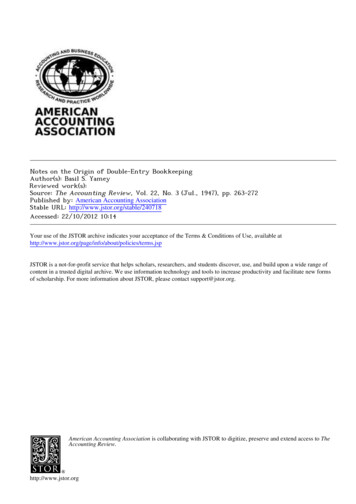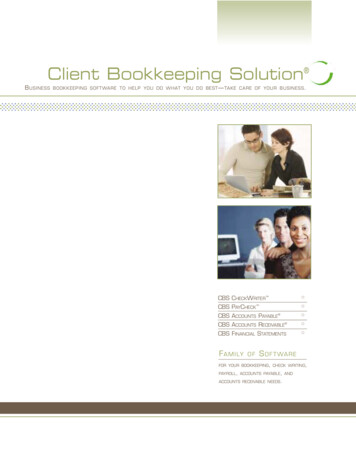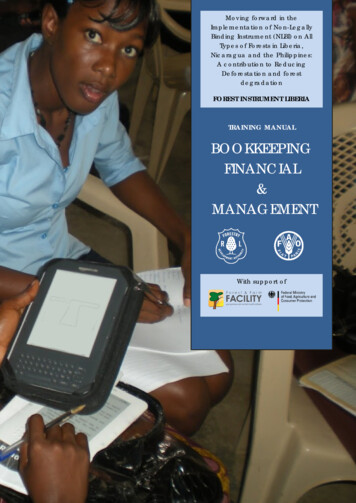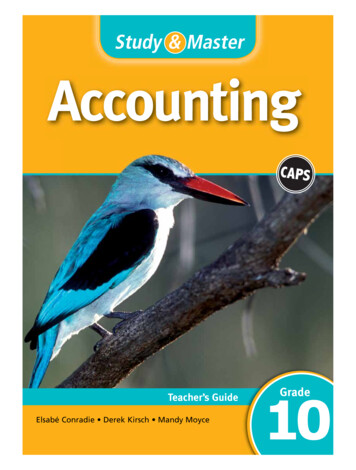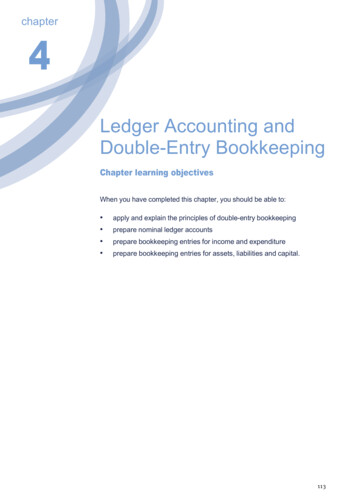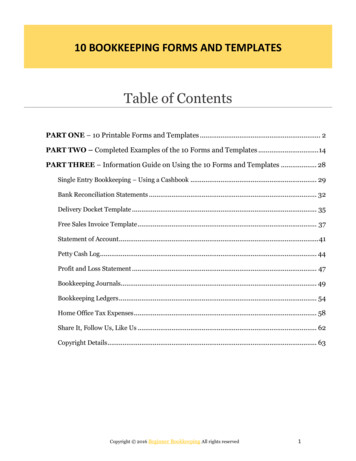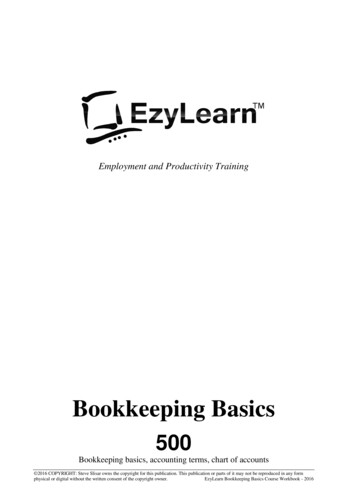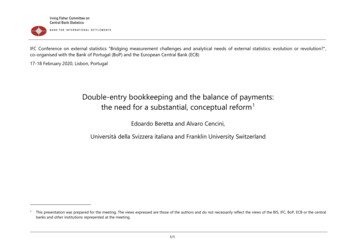
Transcription
IFC Conference on external statistics "Bridging measurement challenges and analytical needs of external statistics: evolution or revolution?",co-organised with the Bank of Portugal (BoP) and the European Central Bank (ECB)17-18 February 2020, Lisbon, PortugalDouble-entry bookkeeping and the balance of payments:the need for a substantial, conceptual reform1Edoardo Beretta and Alvaro Cencini,Università della Svizzera italiana and Franklin University Switzerland1This presentation was prepared for the meeting. The views expressed are those of the authors and do not necessarily reflect the views of the BIS, IFC, BoP, ECB or the centralbanks and other institutions represented at the meeting.1/1
Double-entry bookkeeping and the balance ofpayments: the need for a substantial, conceptualreform.Edoardo Beretta 1; Alvaro Cencini 2AbstractOn the basis of the identity between each country’s global imports and exports, whichis one of the fundamental economic principles of the balance of payments, the paperhighlights why the leading account of transactions from/to the rest of the world needsto be reformed. As a strategic goal, the balance of payments should finally movebeyond its current purely statistical and simple-entry bookkeeping approach in orderto improve its macroeconomic relevance. The creation of an economic account of thenation as a whole and the introduction of a consistent way of recording transactionsfollowing a truly double-entry bookkeeping would also erase statistical discrepanciesex ante and reflect the necessary equality (identity) of credits and debits both for alltransactions taken together and for each of them separately.Keywords: balance of payments; double-entry bookkeeping; nation’s economicaccount; reserve assets.JEL classification: B27; F32; F33; P33.1. IntroductionWe can preliminarily state that the balance of payments (BoP), namely “astatistical statement that systematically summarizes, for a specific time period, theeconomic transactions of an economy with the rest of the world” (IMF 1997, p. 6), isthe most relevant external statistical document registering all international (traceable)commercial and financial transactions between countries. It is common knowledgethat this statistical tool can be separated into a “current account” (CA) and a “capitaland financial account” (CFA). “Reserve assets”, which are a subcategory of the capitaland financial account, mainly keep track of variations in official reserves made up offoreign currencies, precious metals and SDRs. Moreover, “every recorded transactionis represented by two entries with equal values. One entry of these pairs is designated1Edoardo Beretta, Dr. sc. ec. Dr. rer. pol.: Università della Svizzera italiana (USI), Faculty of Economics, ViaGiuseppe Buffi 13, 6904 Lugano, Switzerland, edoardo.beretta@usi.ch.2Alvaro Cencini, Prof. em. Dr. rer. pol. PhD: Università della Svizzera italiana (USI), Faculty of Economics, ViaGiuseppe Buffi 13, 6904 Lugano, Switzerland, alvaro.cencini@usi.ch.Double-entry bookkeeping and the balance of payments: the need for a substantial, conceptual reform1
a credit with a positive arithmetic sign, the other is designated a debit with a negativesign” (IMF 1997, p. 6). So far, nothing new or original. And this is the risk with today’sview of the BoP, that it may be interpreted (wrongly) as a mere tautological statement.To avoid this risk let us analyse critically the double-entry bookkeeping logic behindthe BoP.We begin by analyzing the current notion of BoP: its equilibrium results from“real” flows (CA) matching “financial” flows (CFA). Under these conditions “[t]hebalance of payments must accordingly be looked at as a whole rather than in termsof its individual parts” (Stern 1973, p. 2). However, a similar approach appears to besomewhat reductive since a situation of equilibrium between two distinct transactionsreflects a simple-entry rather than double-entry bookkeeping logic. It would besimplistic – therefore, wrong – to claim that our purchase is our foreigncorrespondent’s sale (which is a truism), when the logic of double-entry bookkeepingrequires both his and our purchases to be matched by simultaneous and equivalentsales. Hence, a second approach (point 2.) should be explored, namely one reflectinga truly double-entry bookkeeping approach. The paper will:-show that every net buyer (seller) on the commercial market (goods/services)must be a net seller (buyer) on the financial market (securities);-re-imagine the role of the “reserve assets” item and, more generally, ofinternational reserves in the BoP itself.The article will explain why today’s system of international payments fails to recognizethe existence of countries as sets of their residents. The methodological approachadopted will be mainly logical-analytical, supported by insights from statisticalevidence.2. The identity between each country’s global imports (IM)and its global exports (EX).The starting point of the discussion is that “countries’ international transactionshave to comply with the BoP identity IM EX, where IM stands for the totality of acountry’s imports, financial and commercial, and EX represents the totality of itsexports, both commercial and financial” (Cencini 2017, p. 150). Even where a CAsurplus (deficit) represents a positive (negative) disequilibrium of the transactionsrecorded therein over those registered in the CFA, the BoP itself is balanced. Thismeans that all the operations in all the accounts taken together are necessarily equalto zero. “As with any other account, the total receipts of a country are bound be equalto the total payments of that country, if one includes all the receipts and all thepayments of the country in the account” (Meade 1970, pp. 3-4).Bearing in mind that “gold” is no longer used to settle international transactions andthat the “purchasing power” used to cover a commercial imports surplus derives fromcorresponding excess financial exports (CA deficits are financed by an equivalent sale2Double-entry bookkeeping and the balance of payments: the need for a substantial, conceptual reform
of financial claims as registered in the CFA), total receipts ( ) are necessarily equal tototal payments (-). Or, as formulated by Krugman and Obstfeld (1997, p. 314), “thisprinciple of payments accounting holds true because every transaction has two sides:if you buy something from a foreigner you must pay him in some way, and theforeigner must then somehow spend or store your payment”. In other words,“[l]ooked at more closely [ ] Krugman and Obstfeld’s quote discloses the presenceof a fundamental law guaranteeing the necessary duality between each resident’ssales and purchases. In fact, if the foreigner from whom a resident buys must spendhis payments – if he stores it, he spends it for the purchase of claims on bank deposits–, this means that the purchase of a resident is necessarily matched by an equivalentsale and that, reciprocally, the sale of the foreign correspondent is balanced by apurchase of the same amount” (Citraro 2004, p. 44). Both individuals are commercialand/or financial buyers and purchasers at the same time and within every transaction.Because of the flow nature of money, the law of the necessary equality of sales andpurchases applies also when transactions concern countries considered as sets of theirresidents.Money conveys reciprocal payments the terms of which are realgoods and financial assets.Although bank money continues to be misinterpreted as an asset or acommodity, it is a fact (“[money is] a circular flow [ ]. [T]he instantaneous reflux ofmoney to its point of origin cannot be identified with an equilibrium condition thatmight be satisfied (or not). It is, in fact, a fundamental law of bank money that willalways be logically true, regardless of the behavior of economic agents” (Pilkington2007, p. 150)). But let us suppose that money is an asset: if so, (inter)nationalexchanges would split up into two non-simultaneous transactions.Goods/services/financial claims of resident A in country A against a sum of money ofresident B in country B would mean a sale for the former and a purchase for the latter.“Money being also considered as a simple veil, the seller will later become apurchaser, yet sale and purchase will be equivalent only at equilibrium (which is butone possible outcome of economic agents’ behaviour), and they will remain twochronologically distinct events” (Cencini 2005, p. 247). In reality, issued by banks as aspontaneous acknowledgement of debt of zero intrinsic value, money is a vehicularmeans by which payments are carried out and not the object of these payments. Byits own nature, money is a flow and not a stock. So, payments that are conveyed bymoney must have a real stock of produced goods and services as their real content.As monetary payments obey the principle of double-entry bookkeeping; each agententering an exchange is simultaneously credited and debited by the same amount ofmoney, whose circular flow is instantaneous. Money is present in each payment andflows immediately back to its point of injection as soon as the payment is completed.Finally, the terms of any exchange are real goods, present and future, conveyedthrough the flow of money. Being at the same time credited (debited) and debited(credited) for the same amount of money, economic agents are, simultaneously,sellers (buyers) and buyers (sellers) of real goods (either in the form of producedgoods and services or in that of financial claims).Double-entry bookkeeping and the balance of payments: the need for a substantial, conceptual reform3
The formulations above describe the so-called “law of the identity between eachagent’s sales and purchases” formulated by Bernard Schmitt (1975). Based on thecircular essence of bank money, every net buyer (seller) on the commercial market(goods/services) must be a net seller (buyer) on the financial market (securities). Putanother way, an economic subject has to finance his purchases by a concurrent saleand – each time he sells – he must concurrently purchase. If this holds true for theindividual agent, it is possible to treat the country itself (the set of its residents) as “asingle macroeconomic agent acting on the commodity and financial markets. Hence,as any single resident can finance his purchases only through equivalent sales, acountry can finance its commercial and financial imports only through equivalentsales of goods, services, and financial assets” (Cencini 2005, S. 248). This is confirmedby the IMF Balance of payments manual stating that “[m]ost entries in the balance ofpayments refer to transactions in which economic values are provided or received inexchange for other economic values. These values consist of real resources (goods,services, and income) and financial items. Therefore, the offsetting credit and debitentries called for by the recording system are often the result of equal amountshaving been entered for the two items exchanged” (IMF 1993, p. 7). The terms “goods,services, and income” refer to the CA, while “financial items” refer to the CFA.Let us take the example of the payment of a reserve currency country’s net imports(e.g. the case of the US). The American nation would pay for its net purchases ofgoods and services by transferring a certain amount of its domestic currency ( 100)to its foreign creditors in the rest of the world (RW). Apparently, U.S. net commercialpurchases are not matched by any sale. However, this conclusion cannot be rightsince it openly contravenes the fundamental reciprocity implied by double-entrybookkeeping. Since money is a circular flow, there cannot be any net transfer of USDollars to the RW. This means that the payment by the American banking systemdoes not prevent the immediate reflux of US Dollars to their point of departure. But,once again, is this not another way of saying that US net commercial purchasesremain unmatched by equivalent sales? It is not. In fact, if on the one hand moneyunits ( 100) are immediately recovered by the American banking system, on the otherhand the rest of the world obtains, through the circular flow of US Dollars, a financialasset (a claim on US bank deposits) while the American nation obtains an equivalentamount of domestic output of RW. This example may be expressed in numerical terms(Table 1). On the one hand, US importers pay for their outstanding commercialtransactions ( 100). On the other hand, exporters from RW receive the countervaluein domestic money (x units of MRW) on their bank accounts. This is the way anytransaction is settled from an individual perspective. Thus, the debtor pays and getsrids of his liability by means of his domestic currency ( 100) – regardless of whetherthe country is a reserve currency or a non-reserve currency one – while the creditoris paid domestic currency (x units of MRW). The U.S. central Bank takes over thepayment of its local importers and transfers it to the banking system of RW. Thecentral Bank’s monetary intermediation makes it possible for US importers to pay intheir local currency ( 100) while the payee gets the countervalue in his local currency.What happens in between is the “monetization of an external gain” by the bankingsystem (represented by its central bank) of RW, which stores the US-Dollar amount inits foreign currency reserves while it creates the countervalue in local money units tothe benefit of RW’s exporters.4Double-entry bookkeeping and the balance of payments: the need for a substantial, conceptual reform
Table 1: Payment of a reserve-currency country’s net imports.Source: representation based on Cencini (2005, p. 248)Therefore, US importers pay 100 while exporters from RW receive x units ofMRW. The transaction is settled from a microeconomic perspective. Let us now lookat what happens on a macroeconomic level, namely between countries as sets ofresidents. Even though the US can pay for its net imports in US dollars, their paymentobeys the same rule applying to any other country. The flow nature of money and thecompliance with double-entry bookkeeping are such that the dollars paid to RW flowimmediately back to the US banking system. Net purchaser of commercial goodsfrom RW, the USA is therefore, at the same time and for the same value, a net sellerof financial claims on US bank deposits. Hence, each country’s purchases, commercialand financial, are funded by equivalent and simultaneous sales.If mainstream economics remarks that “[a]lthough the balance of paymentsaccounts are, in principle, balanced, imbalances result in practice from imperfectionsin source data and compilation” (IMF 2009, p. 11) and the aggregate sum of debtsand credits has to be specifically offset by an item called “net errors and omissions”,it is because it is de facto neglecting that the BoP is not based on an equilibrium, buton an “identity” (IMF 2009, p. 224). In other words, CAB CFAB 0 where CABcorresponds to the CA and CFAB to the CFA balance (“Alternatively, it could be saidthat the current account balance is equal to the sum of balances on the capital andfinancial accounts (with signs reversed, if necessary, depending on the presentationused) including reserve assets” (IMF 2009, p. 224). Yet, accepting that today’s balanceof-payments entries are derived independently from different sources (withconsequent risk of time lags) confirms the implicitly underlying single-entrybookkeeping conception and reduces the BoP itself to a mere collection of statisticaldata instead of being a clear-cut T-account of all external transactions.3. The involvement of CA and CFA in countries’ externaltransactions.Carried out by countries’ residents, cross-border payments concern the systemsof national and of international payments. Both are founded on the use of bankmoney, hence on the necessary equality, the identity, of credit and debit. Economistsall over the world accept this identity. Within nations, national banking systemsDouble-entry bookkeeping and the balance of payments: the need for a substantial, conceptual reform5
function consistently with this principle, while at the international level BoPs are, atleast in theory, assumed to adopt it as a reference. Can double-entry be consideredas a point of equilibrium that can be approximated but hardly or very seldomreached? In no way can logical identity be avoided; but neither can it ever become acondition of equilibrium. If, nonetheless, it is not complied with, a disorder ensues.International payments comply with the logical identity betweenany economic agent’s sales and purchases.Cross-border transactions take place between the residents of any given countryand those of the rest of the world. This is true even in the case of public transactions,for the simple reason that public institutions are residents of their own country.Whether public or private, international payments are carried out by banks incompliance with the double-entry bookkeeping rule establishing the necessarycorrespondence of credits and debits. If a resident a of country A purchasescommercial goods or financial assets of a value equal to x units of money A, MA, froma resident b of country B, it is tautological to say that a’s purchases are b’s sales. It isalso a truism to claim that the payment of a’s purchases defines the debit of a’s bankaccount and the equivalent credit of b’s bank account. If nothing more could be saidabout this payment, we would have to conclude that double-entry is the matching oftwo separate entries in two distinct accounts, each entry being in all respects simple.Reality is far richer: double-entry entails both the debit and the credit of each agentinvolved in any transaction, national or international. Agent a can pay for itsinternational purchases only if it holds the income required to finance them. Either ais the holder of a previously earned income deposited in its bank account, or it obtainsit through a sale of claims on the financial market (we leave aside gifts andinheritance, because irrelevant here). In both cases the identity credit-debit applies toeach single economic agent and to each single transaction. A transposition of theprinciple of double-entry bookkeeping, this identity can also be expressed, as Schmittdid (1975), as the law of the necessary equality between each single agent’s sales andpurchases. This means that every transaction on any market is necessarily balancedby an immediate reverse transaction on another market. When agent a is a purchaseron the trade market of b’s goods, Schmitt’s law states that a is also, at the same time,a seller on the financial market. Bank deposits are financial claims, so that when agives back to its bank the rights on its bank deposits it is indeed selling an amount offinancial assets. Finally, a’s net commercial purchases of b’s real goods are financedby equivalent and simultaneous sales of financial claims. Agent b balances itscommercial sales to a with an equivalent purchase of financial assets, claims on thebank where the proceeds of its sales are deposited.It is thus confirmed that payments between residents, whether of the samecountry or of different countries, comply with the identity of their debits and credits,each purchase being financed by an equivalent and simultaneous sale. In other words,this means that money intervenes to convey reciprocal exchanges the objects ofwhich are commercial and financial assets. Perfectly in line with Adam Smith’sdefinition of money as the ‘great wheel of circulation’ (Smith [1776] 1978, p. 385), thisnotion of money as a ‘vehicle’ is the only one compatible with double-entrybookkeeping. In our example, MA and MB convey the payments between a and b;6Double-entry bookkeeping and the balance of payments: the need for a substantial, conceptual reform
yet, neither MA, nor MB are an object of exchange. What agent a gives in exchangefor a sum of goods sold by b is not a sum of MA, nor is it a sum of MB in which MAis transformed. Both MA and MB are vehicular means of payment; through theircircular flow a and b exchange commercial goods against financial assets. Does thecircular flow of money occur also when countries take over the foreign payments oftheir residents? This question calls for an analysis of the involvement of countries inthe cross-border payments of their residents, State included.The payment of a country’s external transactions and itsimplications for the BoP.The need to transfer abroad the cross-border payments made in nationalcurrency by their residents, leads to the involvement of their countries. If residents ofcountry A are net importers of commercial goods from RW, it is country A that is anet commercial importer, even though A’s imports may not be traced back to anyspecific importer or exporter. The role of countries, or of their central banks, is toconvert the payment in national money of their residents into a payment in foreigncurrency. In other words, they must convey through the ‘international space’ theexternal payments initially carried out in domestic currency. As officially recognizedby international institutions such as the IMF and the World Bank, internationaltransactions carried out by countries must comply with the BoP identity betweenentries in CA and entries in the CFA, the CA being the mirror image of the CFA. Thenecessary equilibrium between the transactions entered in the CA and those enteredin the CFA means that a country’s net commercial imports (resp., exports) must bebalanced by equivalent net financial exports (resp., imports). Hence, A’s net tradesurplus is immediately matched by an equivalent deficit of its CFA. This is so becausethe payment of A’s net imports gives rise to an inflow of foreign currencies into RW,which are immediately invested in A. It is thanks to this investment, corresponding tothe purchase by RW of an equal amount of A’s financial assets, that A can finance itsnet commercial purchases from RW.Expressed as the identity between each country’s global imports, IM, commercialand financial, and its global exports, EX, commercial and financial, the BoP identity isa logical principle accepted worldwide. If it were duly complied with, it wouldguarantee the vehicular use of any currency used to carry out international payments.The IM EX identity establishes the fact that the terms of any international exchangeare always and necessarily real goods, either in the form of commercial goods or offinancial assets. If the trade balance is in equilibrium, both terms of the exchange areactual goods. If it is not, the difference is an exchange between present goods andfuture goods, the latter being the object of the financial claims the export of whichmatches the net import of commercial goods. Being carried out in bank money,international payments taken over by countries are made through debits-credits andcredits-debits, which implies that money is never the object of any payment. As in thecase of payments analysed from the viewpoint of (non-)residents, each countryentering international exchange is debited-credited or credited-debited anytime itcarries out, or is the beneficiary of, a foreign payment. Let us consider the case wherecountry A is paid by RW, in MRW, for its sales of part of its domestic output. As soonas A is credited by R of a sum of MRW it is debited by the same amount: issued byDouble-entry bookkeeping and the balance of payments: the need for a substantial, conceptual reform7
the banks of RW, MRW flows immediately back to its point of departure (doubleentry bookkeeping requires it), and in exchange for its commercial exports, A iscredited with an equivalent claim on RW’s banks, that is, with a claim on a bankdeposit in RW. It is thus confirmed that, between countries, ‘each commercialpayment is a financial payment of inverse algebraic sign, [and] each financial paymentis a zero-sum transaction unless it is founded on a commercial payment of oppositesign’ (Schmitt 2008, p. 3 [our translation]). As a consequence of the identity IM EX,money is an intermediary, a circular means of payment that never replaces the realterms, commercial and financial, of any international transaction.Actually, the preceding conclusion describes the logical nature of internationalpayments and not the way the present system works. IMF and World Bank expertssay that ’[i]n principle, the current and capital accounts should be mirror images’ (IMF1987, p. 12). What is emphasized here is the existence of a discrepancy betweentheory and practice, between the way the system of international payments shouldwork and the way it actually works. In its present form, the BoP is a collection ofstatistical data and not a true bookkeeping representation of countries’ foreigntransactions and payments. We are thus confronted with a number of inconsistencies,such as those denounced by the IMF Working Party in 1987 and concerning the nonzero amount of the world’s CA indicating a disorder the consequences of which,countries’ over-indebtedness, are disastrous for countries and their residents.By erroneously identifying double-entry with simple double-entry (a meretautology) rather than with double double-entry, each entry being simultaneously adebit-credit or a credit-debit, economists have failed to fully recognize the flownature of money. The BoP in its present form is a direct implication of this truncatedconception of double-entry, an analytical instrument not entirely fit for purpose andthat must be re-elaborated according to the true principle of debits-credits and toSchmitt’s law of sales-purchases.4. The reserve account is the account of a country taken asa whole.We have already mentioned that the economic (monetary) definition of “country”or “nation” relies on the money unit involved (US Dollar, Euro, Swiss franc, etc.) andthe corresponding banking system the American, European, Swiss, etc.). By way ofexample, “the United States of America are a single country from an economicviewpoint, since a common money unit has legal validity within this geographicalregion. [ ] In each country, banks are organized according to a pyramidal schemewhile the central bank tops this banking structure” (Schmitt 1990, pp. 34-36 [ourtranslation]). Hence, the monetary unit of physical production, which is used in thepayment of wages, has a crucial role in defining each country’s monetary space.8Double-entry bookkeeping and the balance of payments: the need for a substantial, conceptual reform
Net foreign currency flows modify the IIP of countries defined as“sets of their residents”.Foreign currencies play a major role in external trade. Not surprisingly, the BoPalso records a statistical item called “reserve assets”, which “are readily available toand controlled by monetary authorities for meeting balance of payments financingneeds, for intervention in exchange markets to affect the currency exchange rate, andfor other related purposes (such as maintaining confidence in the currency and theeconomy, and serving as a basis for foreign borrowing)” (IMF 2009, p. 111). At thesame time, “foreign currency liquidity” represents a broader concept than “reserveassets” or “international reserves”, because it “concerns foreign currency resourcesand drains on such resources of the monetary authorities and the central government[ ], relates to the authorities’ foreign currency claims on and obligations to residentsand nonresidents and [ ] encompasses inflows and outflows of foreign currency thatresult from both on- and off-balance-sheet activities of the authorities” (IMF 2013, p.4). Regardless of whether “reserve assets” or “foreign currency liquidity” are involved,it remains true that the flows of net foreign currencies modify the InternationalInvestment Position (IIP) of countries defined as “sets of their residents”.Let us separate this assertion into two distinct parts, of which the first is the moreintuitive. Since “the difference between the assets and liabilities is the net position inthe IIP and represents either a net claim or a net liability to the rest of the world” (IMF2019, Internet), it goes without saying that net foreign currency outflows (resp.,inflows) reduce (resp., increase) the net claims of a country as whole. The second partof the previous statement is equally true, but needs an more explanation. In fact, wehave to demonstrate why countries have to be conceived as “whole sets of theirresidents” instead of the more intuitive formulation of “aggregate or sum of theirresidents”. More precisely, countries or nations are monetarily speaking the “set oftheir private/public economic subjects (including the State)”. Why "State" is notsynonymous with "nation" or "country" is plain to see, since the public sector isnothing more than a part, a component, of the economy as a whole (which includesalso private, financial and non-financial subjects). But, why would it be wrong to claimthat countries do not correspond to the aggregate of all (private and public)economic subjects? While the concept of “sum” implies that all economic actors (S1,., Sn) of the nation are to be taken together:country (𝑆𝑆1 , . , 𝑆𝑆𝑛𝑛 ),a “set” is not limited to their aggregation. If we represent the macroeconomicconcept of “country” by means of an ellipse or a circle containing several elements(national private-public residents), the “set” would correspond to the ellipse/circle asa whole (all its components, including its perimeter):country {𝑆𝑆1 , , 𝑆𝑆𝑛𝑛 }.Double-entry bookkeeping and the balance of payments: the need for a substantial, conceptual reform9
As reminded by Cencini (1997, p. 341), “[i]n the same way as the set is richer thanits constitutive elements, the nation is a whole which acquires an existence which ispartially autonomous from that of its residents. [ ] However, if it is correct to claimthat a set cannot be reduced to the sum of its elements, this does not mean that thesit
Double-entry bookkeeping and the balance of payments: the need for a substantial, conceptual reform 1 Double-entry bookkeeping and the balance of payments: the need for a substantial, conceptual reform. Edoardo Beretta 1; Alvaro Cencini. 2. Abstract . On the basis of the identity b
